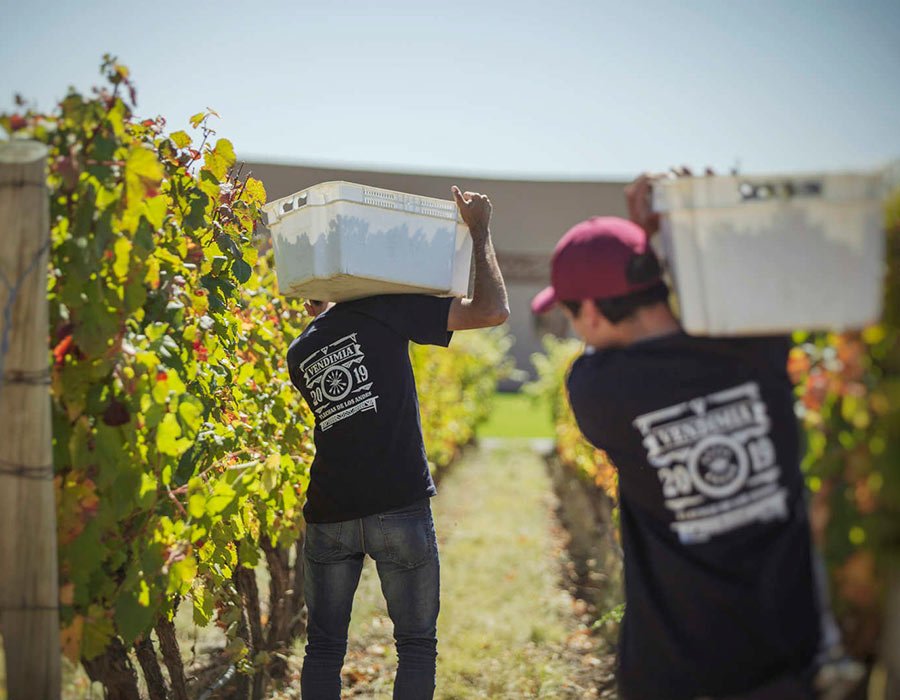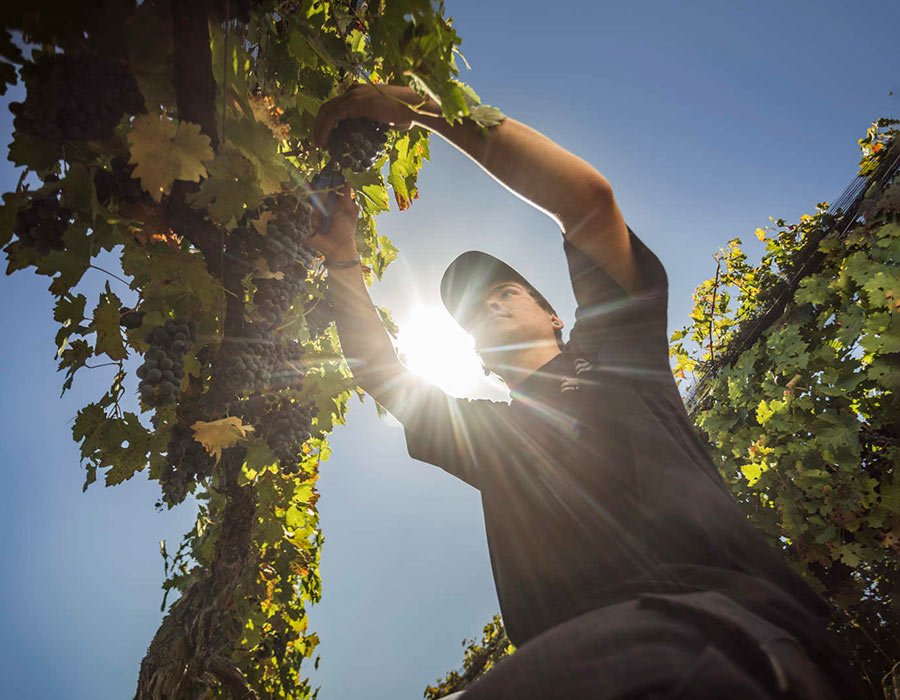The winter of 2022 was dry, with low snowfall, marking the start of a dry growing cycle. On 31 st October and 1 st November, there were late frosts in all the grape-growing areas of the country, causing a 20% drop in production in our vineyard.
The entire remaining spring period and the summer in general was hot and dry.
Average temperatures were well above historical averages, with lows close to 20ºC.
During March, with the same weather trend, we began the harvest on 3 rd , marking the earliest harvest ever for Flechas de los Andes.
However, the second half of March was finally rainy and cool, which made it possible to pause the harvest and restart it in the first days of April.
This led us to achieve two completely distinct profiles for the different components for our blends.


A challenging harvest: 2022
Our vines sprout in mid-September and all areas of Mendoza suffered a major frost on October, 3rd, causing a decrease in yields but at the same time a natural thinning. This gives always higher quality in the final product.
The weather from November to March was marked by dry seasons with heat waves and wet and cool times. This oscillating climate, uncommon in our semi-desert area, challenged us durging all the season. It gave us no truce until the last moment, since Mendoza was punished by an early historic frost on March, 31st.
Flechas de los Andes fortunately did not suffer the frost but the temperatures of +1º advanced the drying up of the vines. This obligued the winery team to do more than 80% of the harvest in 2 weeks, becoming the shortest harvest in our experience.
The results of the first wines are excellent, with a high intensity of colour, good acidity and a lot of freshness.
We will remember the 2022 harvest as the one of a cool year for our climate, granting wines of long duration.

The 2021 harvest has been one of excellent quality. From the beginning, when the vines were sprouting and until the end of the veraison, the weather in Mendoza was a little drier than usual. This resulted in very healthy grapes.
In general, the year 2020 was very hot and dry. But in early 2021, when veraison began, the weather was cool and slightly humid, which allowed for a continuous ripening of the grapes.
During the month of February there was frequent rainfall, which made it possible for the tannins and the sugars to ripen slowly and continuously. This allowed harvesting to begin on March 22nd, obtaining wines of great colour, good acidity and a lot of freshness.
Given the conditions, the plan for the harvest was to wait and pick the grapes gradually, in order to obtain a range of different profiles: from more tense, sharp and elegant wines to unctuous wines with good sucrosity.
In general, the wines of 2021 will have moderate alcohol content and a lot of freshness and fluidity. The slow and gradual grape ripening gave origin to wines with a higher concentration of malic acid, malolactic fermentation playing a major role in the final balance of these wines.
We emphasize once again the importance of our terroir: a stony profile and great runoff, allowed our plants and grapes to resist the Botrytis problem during a rainier than normal end of the veraison.
We are very proud of the quality of our Malbec and Cabernet Franc. Definitely, the 2021 harvest has given birth to many great wines of Mendoza.
Now that the harvest is over, we can toast to the quality of the wines obtained.
This was an unusual harvest by all means. From the climate perspective it`s been a unique year. January`s high temperatures gave a strong footprint in the style of this harvest. Even though the high temperatures we had, what it was very particular, was to have high minimum temperatures. Such a climate event, produce an smaller thermal amplitude and an earlier sugar ripeness. On top of that, February was very dry and therefore we had an early ripeness.
This harvest has been the earliest harvest in the past 50 years, also for us, as Flechas de los Andes the earliest since we start in 2004. But we have to remember the weather in Mendoza is dry and hot, and that is essential for our Terroir. Malbec grape get used to high temperatures very nicely, developing thick skins in the grapes, full of tannins and anthocyanin. Those components are the base of the color, taste and the intensity of our wines.
Since it was a very early harvest, we had to adjust our vinification process, shorter macerations so we can obtain good structure but also soft and elegant wines. We are very pleased with the quality of the wines, and we believe they will have a great Argentine expression.
Perhaps one of the best weather cycles in our young history.
We started with a very cold winter, essential to allow our vines to rest. Then, a
spring that was sunny yet mild in temperature. In general, with a moderate berry
setting, thus giving a good yield of clusters.
During the summer, the vineyards went through a very typical Mendoza
summer period, with an excellent thermal amplitude and mainly cool nights.
The end of summer and beginning of autumn were drier than usual, allowing for
good health and a gradual and prolonged harvest.
In conclusion all of this was, an ideal wine year, which allowed our technical
team to produce great wines over time with precision, where we can find
freshness, structure and elegance.
This harvest has been the earliest harvest in the past 50 years, also for us, as Flechas de los Andes the earliest since we start in 2004. But we have to remember the weather in Mendoza is dry and hot, and that is essential for our Terroir. Malbec grape get used to high temperatures very nicely, developing thick skins in the grapes, full of tannins and anthocyanin. Those components are the base of the color, taste and the intensity of our wines.
Since it was a very early harvest, we had to adjust our vinification process, shorter macerations so we can obtain good structure but also soft and elegant wines. We are very pleased with the quality of the wines, and we believe they will have a great Argentine expression.

The 2017 harvest was exceptional in terms of health, quality and polyphenolic maturity.
The production however, was lower due to two late frosts the occurred on October 21 st and 31 st . In 2017, the months of January, February and March were very dry, which together with the fact that overall it was a cool year, allowed a gradual ripening that favoured the development of aromas of fresh red fruits: plum, strawberry and black fruits such as blackberry and blueberry. Good nerve acidity and balanced sweetness. The harvest was between 7 and 10 days ahead of the usual harvest date.

The year 2015 was a cold year. The season was characterized by a cool spring, with frosts and snow on September 21 st and a very warm summer.
The weather was very rainy at the end of the ripening cycle, which led to a slightly less mature harvest, somehow delayed compared to the usual harvest dates.
There were also some sanitary problems in some varietals such as Cabernet Sauvignon at the end of the season.

The characteristics of the 2014 vintage are the result of a cold year, such as greater freshness due to higher acidity and higher concentration.
The months of February, March and April were quite cool; this and the late frosts of September of the previous year, caused a decreased production and a delayed harvest compared to historical values and dates.

The year 2013 was warmer than subsequent years.
However, the cool nights in summer and autumn favoured a balanced acidity in the grapes, high intensity of aromas and velvety tannins.
All in all, 2013 was an average year with good bud break and shooting, standard yields and good aging potential.